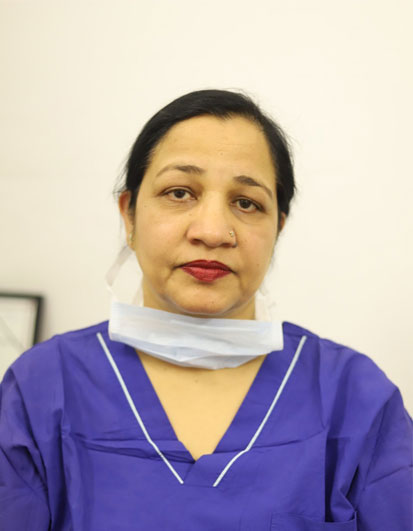
Cervical Cancer Treatment
You are considering coming to me for suspected cervical cancer. Chances are that you have seen your local
doctor or a gynecologist who has done a pap smear test and also performed colposcopy to check your cervix.
Questions that you may have in your mind include:
- Which hospital should I go to for treating my cervical cancer?
- Will I need to undergo surgery and chemotherapy?
- What are chances of a full recovery?
As a Surgical Specialist working in Gynaecological oncosurgery I am doing laparoscopic radical
hysterectomy and work hand in hand with various medical & radiation oncologists to help cervical cancer
patients achieve the best possible outcome and support them in their recovery after surgery.
If you are not a cervical cancer patient, then you should include in your screening routine the Pap smear
test and pelvic examination such as colposcopy . These are important parts of a woman’s health care
because they can detect abnormalities that may lead to invasive cancer of the cervix. Seek treatment for
these abnormalities before cervical cancer develops.
Most invasive cancers of the cervix can be treated on time if women have Pap tests regularly. Also, as
with many types of cancer, cancer of the cervix is more likely to be treated successfully if it is
detected early. You may also consider having the HPV Vaccines to protect against some HPV infections and
genital warts
Ovarian Cancer
The ovaries are part of a woman's reproductive system. They are in the pelvis. Each ovary is about the size of an almond. The ovaries make the female hormones -- estrogen and progesterone. They also release eggs. An egg travels from an ovary through a fallopian tube to the womb (uterus).
When a woman goes through her "change of life" (menopause), her ovaries stop releasing eggs and make far
lower levels of hormones. Understanding ovarian cancer Cancer begins in cells, the building blocks that
make up tissues. Tissues make up the organs of the body. Normally, cells grow and divide to form new cells
as the body needs them. When cells grow old, they die, and new cells take their place. Sometimes, this
orderly process goes wrong. New cells form when the body does not need them, and old cells do not die when
they should. These extra cells can form a mass of tissue called a growth or tumor. Tumors can be benign or
malignant: Benign tumors are not cancer: Benign tumors are rarely life-threatening.
Generally, benign tumors can be removed. They usually do not grow back. Benign tumors do not invade the
tissues around them. Cells from benign tumors do not spread to other parts of the body. Malignant tumors
are cancer: Malignant tumors are generally more serious than benign tumors. They may be life-threatening.
Malignant tumors often can be removed. But sometimes they grow back. Malignant tumors can invade and
damage nearby tissues and organs. Cells from malignant tumors can spread to other parts of the body.
Cancer cells spread by breaking away from the original (primary) tumor and entering the lymphatic system
or bloodstream. The cells invade other organs and form new tumors that damage these organs. The spread of
cancer is called metastasis.
An ovarian cyst may be found on the surface of an ovary or inside it. A cyst contains fluid. Sometimes it
contains solid tissue too. Most ovarian cysts are benign (not cancer). Most ovarian cysts go away with
time. Sometimes, a doctor will find a cyst that does not go away or that gets larger. The doctor may order
tests to make sure that the cyst is not cancer.
Cancer cells can spread through the lymphatic system to lymph nodes in the pelvis, abdomen, and chest.
Cancer cells may also spread through the bloodstream to organs such as the liver and lungs. When cancer
spreads from its original place to another part of the body, the new tumor has the same kind of abnormal
cells and the same name as the original tumor. For example, if ovarian cancer spreads to the liver, the
cancer cells in the liver are actually ovarian cancer cells. The disease is metastatic ovarian cancer, not
liver cancer. For that reason, it is treated as ovarian cancer, not liver cancer. Doctors call the new
tumor "distant" or metastatic disease.
There is increased awareness of ovarian cancer's link to the BRCA1 and BRCA2 gene mutation highligted in
the media by American actress Angelina Jolie's mastectomy. If two or more close family members have had
breast cancer, you may want to test for BRCA gene mutation to assess your risk of breast cancer and
ovarian cancer.
Surgery/Cytoreductive surgery is done for patients with ovarian cancer
Surgery for endometrial cancer (Uterine)
These are discussed in detail below.
Hysterectomy
The main treatment for endometrial cancer is an operation to remove the uterus and cervix (called a
hysterectomy).
When endometrial cancer has spread to the cervix or the area around the cervix (called the parametrium), a
radical hysterectomy is done. In this operation, the entire uterus, the tissues next to the uterus
(parametrium and uterosacral ligaments), and the upper part of the vagina (next to the cervix) are all
removed. Both fallopian tubes and ovaries are removed at the same time. This operation is most often done
laparoscopically.
Laparoscopy is used to help safely remove the necessary organs and tissues. Laparoscopy is a technique
that lets the surgeon look at the inside of the abdomen and pelvis through tubes inserted into very small
incisions. Small surgical instruments are used, allowing the surgeon to operate without a large incision
in the abdomen. This can shorten the time needed for recovery from surgery. Both a hysterectomy and a
radical hysterectomy can also be done through the abdomen using laparoscopy.
Bilateral salpingo-oophorectomy
This operation removes both fallopian tubes and both ovaries. This procedure is usually done at the same
time the uterus is removed (either by simple hysterectomy or radical hysterectomy) to treat endometrial
cancers. Removing both ovaries means that you will go into menopause if you have not done so
already.
Lymph node surgery
Pelvic and para-aortic lymph node dissection: This operation removes lymph nodes from the pelvis and the
area next to the aorta to see if they contain cancer cells that have spread from the endometrial tumor. It
is called a lymph node dissection when most or all of the lymph nodes in a certain area are removed. This
procedure is usually done at the same time as the operation to remove the uterus.
Team of SENIOR Gynaecologists at Chawla Nursing Home

Dr. Sushma Chawla
M.D. (P.G.I), FICMCH, FICOG,
Sr. Consultant Obstetrician & Gynaecologist,
Gynae. Laparoscopic & Hysteroscopic Surgeon,
IVF SPECIALIST

DR.ANUPMA CHOPRA
M.D. (Obstetrician & Gynaecologist) CONSULTANT IVF Specialist

Dr. Deepali Luthra
M.B.B.S., DFW, DIP. GO (ICMCH)
Obstetrician & Gynaecologist,
Hysteroscopist & Colposcopist,
IVF Specialist

Dr.Rajeshwari
M.B.B.S., DFW, DIP GO (ICMCH),
Obstetrician & Gynaecologist



